Lordly Shades

Lordly shades of gods, demons and heroes of old cast their puppet shadows upon a screen to relate supernatural histories teaching men how to live wisely. This is Wayang Purwa.
Wayang Purwa is a form of theatre. It is ancient, for it originated in the day of primitive man; it is very beautiful, both to ear and eye, and it has a spell binding effect upon millions of Indonesians. Wayang Purwa is a mine of the ethical teaching inherent in Indonesian culture, and it is a medium of communication capable of acting as an agent of change in the fast changing world of modern Indonesia.
The word wayang means shadow, while purwa means ancient. Wayang Purwa is a shadow show for which the ancient Ramayana and Mahabarata stories from the repertoire. The shadows are cast on white screen by flat leather puppets that are stiff ended by horn handles and manipulated by a puppeteer, who is called the dalang.
Wayang Purwa grew out of the ancestor worship of primitive man and the calling up of ancestral spirit to advise their descendants how to solve the problems of life. The shadows of Wayang Purwa that flicker on the screen make the puppets come alive , while the voice , the music and the knocking sound from behind the screen can conjure up an eerie effect as the gods and men of wayang plays fight to overcome trickery and evil doing.
The earliest known written reference to a wayang performance comes from an 11th century poem, which indicates that Wayang Purwa was already a well established and popular form of art at the time, sufficiently like what we know today to be easily recognizable. How much older this particular type of presentation is, we have no means of knowing. It certainly must have taken a long time to develop a popular form of theatre with the puppets casting shadows on a screen, recitative by a dalang and an orchestral accompaniment.
The technical terms connected with Wayang Purwa performances come from the old Javanese and Old Malay languages, and there is no reason to think that wayang has any origin other than Javanese, even if the Mahabharata and Ramayana epics originated in ancient India. For one thing, the wayang stories have some key characters who do not exist in the epics known in India. This is the case with the Panakawan , for instance , the clown who appear as retainers of the main characters and who help their masters and mistresses to gain their ends. Then there are more adventures and far more complicated plots in the Indonesian stories of the Ramayana and Mahabharata. Moreover, in the wayang stories, but nit in the Indian epics, the Ramayana and the Mahabharata are a continuous series, some of the characters of the Ramayana appearing again in the Mahabharata. In addition, notable characters, including the gods of the Hindu pantheon, are shown in the wayang stories of Indonesia to be descendants of the Biblical and Koranic Adam.
Relief’s carved in stone on 14th century East Java temples show wayang characters in “realistic” forms. But with the dominance of Islam in Java in the 15th century, the puppets of heroes and heroines were stylized in deference to Islam’s aversion to images in human from. In this way , the puppets came to have additional resemblance to elongated shadows. To this very day, however, the wayang puppets used in Bali are similar in from to the East Java temple carvings. Bali is still Hindu and so has lacked the need to alter the froms from the 14th century style. For this reason, Balinese Wayang Purwa, which is called Wayang Purwa and Wayang Ramayana there, is recognized as the earliest form of the art known today.
The changes in historical times were, no doubt, but a continuation of numerous changes in the growth of wayang in the many centuries of its unrecorded history. Wayang is still changing. During this century, for example, women singers called pesinden have been introduced; it has become far more popular to view performances from behind the dalang, not from the shadow side of the screen; and the old oil lamp, the blenchong is being light and so makes it possible for larger audiences to watch performances.
There are many different kinds of wayang today. If we use the term “wayang” to refer to any kind of theatrical performance in which the director plays an active part on stage, we can say that there are some seventy different types and styles of wayang performance to be found in Indonesia. This is the modern definition of wayang used by the Government Directorate for the Arts.
Some of the other kinds of wayang include Wayang Gedog, which, with puppets similar to those of Wayang Purwa, has a repertoire of legends from East Java; Wayang Suluh and Wayang Wahyu, which use modern texts, the first for the purposes of government information service and the second for religious purposes among Catholics; Wayang Golek, with its three dimensional wooden puppets wearing real clothes, which is not a shadow play at all and which is veru popular in West Java; and Wayang Wong, or Wayang Orang as it is also called, with live actors and actresses . There are still many more kinds and varieties, some of an experimental character.
Wayang Purwa, however, is still by far the most popular of all these forms. The flat puppets made of parchment, tooled and perforated, painted and gilded, and with beautifully polished horn supports and handles, are works of art in themselves.
The repertoire is an extensive one, traditionally consisting of 177 plays. There are 7 play about the gods and demons of the Ramayana-Mahabharata pantheon; 5 plays of the Lokapala, also called the Arjuna Sasrabau, which is a prelude to the Ramayana; 18 plays of the Ramayana it self , and 147 plays of the Mahabharata. Of course, all these are the Indonesian stories, not the Indian epics, and all the plays, as has been remarked already, constitute a single series.
The stories presented in these are imbued with moral and ethical education. Over and beyond everything else, Wayang purwa is concerned essentially with ethnics and education. Whatever the changes made in wayang over the centuries since its remote origins, its ethical heart has remained unaltered.
Wayang Purwa performances are almost invariably given at night time, very likely in continuation of their ancient function of calling up the souls of the ancestors. A Wayang Purwa performance usually begins around 9 p.m. and continues without break until dawn the morning. There are no “intervals” between acts.
Wayang Purwa is among the world’s few structured plays. The in built structure of Wayang Purwa is related both to the time of the night and also to a traditional sequence of acts and scenes.
Whether the story is drawn from the Ramayana or the Mahabharata, the play opens in a royal court or in the audience hall of one of the gods. King or deity draws attention to some serious problem and calls upon princes, ministers, advisors and knights to deal with the matter. A course of action is decided and various people set about accomplishing the mission. The play usually follows the journeying of the main characters through forests, encounters with demons and the like; usually some inconclusive fighting will take place at this stage.
This goes on until around midnight, the time at which the clown retainers come on stage for some topical comment and slap stick. Then the play continues and the action unfolds the various complication of the problem that was discussed in the opening sequence. Very likely there will be dramatic encounters and unexpected twist to the plot, while some serious mishaps may occur.
The action builds up to a great climax for the third part of the play, in which there may be a tremendous battle between armies, or at least protracted and eventually conclusive fighting between the main contending parties. This all leads to the solution of the problem, with the forces of good finally victorious. The dalang then manipulates a three dimensional wooden puppet called golek, picturing a female dancer, who dances before the assembled victors to the accompaniment of joyful music. With this, the dalang ends the night long play.
Wayang Purwa is a form of theatre. It is ancient, for it originated in the day of primitive man; it is very beautiful, both to ear and eye, and it has a spell binding effect upon millions of Indonesians. Wayang Purwa is a mine of the ethical teaching inherent in Indonesian culture, and it is a medium of communication capable of acting as an agent of change in the fast changing world of modern Indonesia.
The word wayang means shadow, while purwa means ancient. Wayang Purwa is a shadow show for which the ancient Ramayana and Mahabarata stories from the repertoire. The shadows are cast on white screen by flat leather puppets that are stiff ended by horn handles and manipulated by a puppeteer, who is called the dalang.
Wayang Purwa grew out of the ancestor worship of primitive man and the calling up of ancestral spirit to advise their descendants how to solve the problems of life. The shadows of Wayang Purwa that flicker on the screen make the puppets come alive , while the voice , the music and the knocking sound from behind the screen can conjure up an eerie effect as the gods and men of wayang plays fight to overcome trickery and evil doing.
The earliest known written reference to a wayang performance comes from an 11th century poem, which indicates that Wayang Purwa was already a well established and popular form of art at the time, sufficiently like what we know today to be easily recognizable. How much older this particular type of presentation is, we have no means of knowing. It certainly must have taken a long time to develop a popular form of theatre with the puppets casting shadows on a screen, recitative by a dalang and an orchestral accompaniment.
The technical terms connected with Wayang Purwa performances come from the old Javanese and Old Malay languages, and there is no reason to think that wayang has any origin other than Javanese, even if the Mahabharata and Ramayana epics originated in ancient India. For one thing, the wayang stories have some key characters who do not exist in the epics known in India. This is the case with the Panakawan , for instance , the clown who appear as retainers of the main characters and who help their masters and mistresses to gain their ends. Then there are more adventures and far more complicated plots in the Indonesian stories of the Ramayana and Mahabharata. Moreover, in the wayang stories, but nit in the Indian epics, the Ramayana and the Mahabharata are a continuous series, some of the characters of the Ramayana appearing again in the Mahabharata. In addition, notable characters, including the gods of the Hindu pantheon, are shown in the wayang stories of Indonesia to be descendants of the Biblical and Koranic Adam.
Relief’s carved in stone on 14th century East Java temples show wayang characters in “realistic” forms. But with the dominance of Islam in Java in the 15th century, the puppets of heroes and heroines were stylized in deference to Islam’s aversion to images in human from. In this way , the puppets came to have additional resemblance to elongated shadows. To this very day, however, the wayang puppets used in Bali are similar in from to the East Java temple carvings. Bali is still Hindu and so has lacked the need to alter the froms from the 14th century style. For this reason, Balinese Wayang Purwa, which is called Wayang Purwa and Wayang Ramayana there, is recognized as the earliest form of the art known today.
The changes in historical times were, no doubt, but a continuation of numerous changes in the growth of wayang in the many centuries of its unrecorded history. Wayang is still changing. During this century, for example, women singers called pesinden have been introduced; it has become far more popular to view performances from behind the dalang, not from the shadow side of the screen; and the old oil lamp, the blenchong is being light and so makes it possible for larger audiences to watch performances.
There are many different kinds of wayang today. If we use the term “wayang” to refer to any kind of theatrical performance in which the director plays an active part on stage, we can say that there are some seventy different types and styles of wayang performance to be found in Indonesia. This is the modern definition of wayang used by the Government Directorate for the Arts.
Some of the other kinds of wayang include Wayang Gedog, which, with puppets similar to those of Wayang Purwa, has a repertoire of legends from East Java; Wayang Suluh and Wayang Wahyu, which use modern texts, the first for the purposes of government information service and the second for religious purposes among Catholics; Wayang Golek, with its three dimensional wooden puppets wearing real clothes, which is not a shadow play at all and which is veru popular in West Java; and Wayang Wong, or Wayang Orang as it is also called, with live actors and actresses . There are still many more kinds and varieties, some of an experimental character.
Wayang Purwa, however, is still by far the most popular of all these forms. The flat puppets made of parchment, tooled and perforated, painted and gilded, and with beautifully polished horn supports and handles, are works of art in themselves.
The repertoire is an extensive one, traditionally consisting of 177 plays. There are 7 play about the gods and demons of the Ramayana-Mahabharata pantheon; 5 plays of the Lokapala, also called the Arjuna Sasrabau, which is a prelude to the Ramayana; 18 plays of the Ramayana it self , and 147 plays of the Mahabharata. Of course, all these are the Indonesian stories, not the Indian epics, and all the plays, as has been remarked already, constitute a single series.
The stories presented in these are imbued with moral and ethical education. Over and beyond everything else, Wayang purwa is concerned essentially with ethnics and education. Whatever the changes made in wayang over the centuries since its remote origins, its ethical heart has remained unaltered.
Wayang Purwa performances are almost invariably given at night time, very likely in continuation of their ancient function of calling up the souls of the ancestors. A Wayang Purwa performance usually begins around 9 p.m. and continues without break until dawn the morning. There are no “intervals” between acts.
Wayang Purwa is among the world’s few structured plays. The in built structure of Wayang Purwa is related both to the time of the night and also to a traditional sequence of acts and scenes.
Whether the story is drawn from the Ramayana or the Mahabharata, the play opens in a royal court or in the audience hall of one of the gods. King or deity draws attention to some serious problem and calls upon princes, ministers, advisors and knights to deal with the matter. A course of action is decided and various people set about accomplishing the mission. The play usually follows the journeying of the main characters through forests, encounters with demons and the like; usually some inconclusive fighting will take place at this stage.
This goes on until around midnight, the time at which the clown retainers come on stage for some topical comment and slap stick. Then the play continues and the action unfolds the various complication of the problem that was discussed in the opening sequence. Very likely there will be dramatic encounters and unexpected twist to the plot, while some serious mishaps may occur.
The action builds up to a great climax for the third part of the play, in which there may be a tremendous battle between armies, or at least protracted and eventually conclusive fighting between the main contending parties. This all leads to the solution of the problem, with the forces of good finally victorious. The dalang then manipulates a three dimensional wooden puppet called golek, picturing a female dancer, who dances before the assembled victors to the accompaniment of joyful music. With this, the dalang ends the night long play.


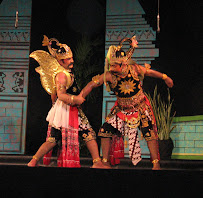


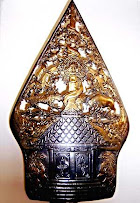
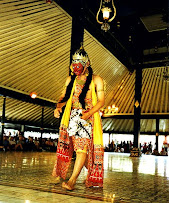


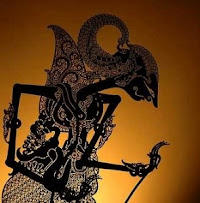




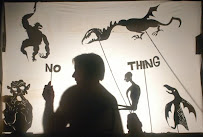
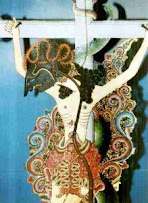






0 komentar:
Posting Komentar